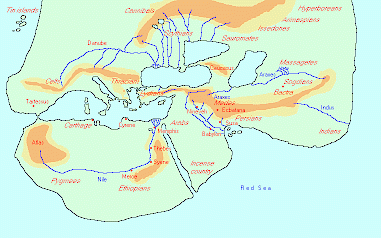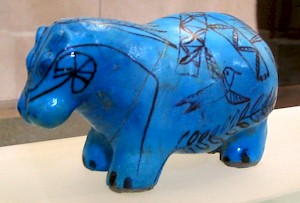Hecataeus of Miletus
Hecataeus of Miletus (c.550-c.490): Greek geographer and researcher, designer of a world map and author of a book on chronology.

The sixth century BCE was the fin de siècle of the old Greek elite. Always, the towns and tribes had been ruled by aristocrats, but merchants had expanded the traditional frontiers of the known world and had earned lots of money. In the sixth century, these nouveaux riches became increasingly influential. Unlike the aristocrats, who often claimed the Homeric heroes as their ancestors and used this claim as a source of legitimacy, the new elite had no traditional prestige.
On the other hand, they had novel ideas, which were not based on tradition but on rational thought and empiricism. People like Thales of Miletus, Anaximander of Miletus, Anaximenes of Miletus, and Heraclitus of Ephesus, are usually called the first philosophers. Perhaps they were not completely original (some of their ideas have Babylonian parallels, and they may indeed have learned something in the east), but their critical attitude makes them the founders of western science.
This was the intellectual world of Hecataeus. He was born in the great city of Miletus, probably somewhere between 560 and 550 BCE, shortly before the Persian king Cyrus the Great conquered the Lydian Empire and the Greek towns that belonged to it. Centuries later, the Greek geographer Strabo of Amasia called Hecataeus a student of Anaximander. Chronologically, this is almost impossible, but it cannot be denied that the philosopher has influenced Hecataeus' ideas about cosmogony (the birth of the universe) and the shape of the world.
We know hardly anything about Hecataeus' life, although he seems to have traveled to countries like Egypt, which was visited by not a few Greeks in the company of the Persian king Cambyses, who conquered the ancient country of the Nile in 525.
About half a century after his death, in c.490, another researcher, Herodotus of Halicarnassus, wrote in his Histories that Hecataeus had understood the size and power of the Persian Empire, and had advised his compatriots not to rebel against king Darius I the Great.note They did not listen. The Ionian revolt, as the insurrection of the Greek towns in the Persian empire is called, was initially successful, but eventually, the rebels were defeated. Miletus was destroyed in 494, and rebuilt on another site. A late tradition, retold by Diodorus of Sicily,note says that Hecataeus conducted the negotiations between the Milesians and the new satrap, Artaphernes, and obtained a favorable treatment. It may be true. We do not know the date of Hecataeus' death.
His best-known work is his World map, which was based on a map that had been designed by Anaximander. Hecataeus' map is described by Herodotus:
I laugh when I see that many have designed maps of the earth, yet no one has been able to present the matter in an intelligent way. They draw an Ocean flowing round the earth, which they present as exactly circular, and they make Asia equal in size to Europe.note

Although Hecataeus is not explicitly mentioned, most scholars agree that Herodotus has been laughing at his predecessor. (As a matter of fact, the younger researcher did indeed produce a better map.) Hecataeus' map is divided into three thirds (Europe, Asia, Africa), which are divided by the Mediterranean, the Red and the Black Seas. At the same time, the map shows a division in four quadrants: western Africa is separated from eastern Africa and the Near East by the Nile; the Near East from Europe by the Black Sea and Caucasus; and Europe is divided in an eastern and western half by the Don. There are more indications that Hecataeus' map was extremely schematic - although less schematic than Anixamander's map had been. Although Herodotus showed that this scheme was incorrect, Hecataeus' map was a great advance, because he understood the relative positions of the continents.
The map can be seen as a synopsis of Hecataeus' Description of the earth (Periegesis or Periodos ges). In two volumes, called 'Europe' and 'Asia', the author described the coasts of the Mediterranean Sea - in the first part from west to east, and in the second volume from east to west, including the African coast. Sometimes, Hecataeus left the coast and went upstream along a river. The surviving fragments show that his prose was clear and unadorned, and that the author was interested in towns, distances, rivers, mountains, nations, tribes, and boundaries. Customs, animal life, flora, scenery, mythology, and the stories about the foundation of a town were not ignored. On the other hand, historical information seems to have been almost absent.
The book also included the coast of the Atlantic Ocean: there was at least one reference to Melitta (modern Oualiddia) in the west of Marocco. This reference is extremely important, because it proves that Hecataeus had - direct or undirect - access to the travel log of the Carthaginian voyager Hanno, who had visited this region. Unfortunately, we have no idea about Hecataeus' other sources, although we know that Hecataeus visited Egypt and may assume that he received information from Greek sailors.

The Description of the earth survives in the form of 330 usually very brief fragments. One quote, however, is quite long: the description of Egyptian animals (hippopotamus, crocodile, phoenix) that can be found in the second book of Herodotus' Histories. You can read it here. Unfortunately, the story about the hippo does not really suggest that Hecataeus had actually seen this animal. It has been assumed that in the sixth century, the hippopotamus was no longer living in Egypt. Hecataeus may have heard a tale, and Herodotus must have copied it. Another story that Herodotus copied from Hecataeus is the highly schematic description of the Sahara.
Hecataeus also published the Genealogies (sometimes called Histories, 'researches'), a history of the Greek heroes. About forty fragments have survived. Its first line has become famous:
Hecataeus of Miletus says: I write down what I think is true, because the stories told by the Greeks are, in my opinion, ridiculous and countless.
This is the statement of a man who tried to systematize the loose and unrelated - and therefore ridiculous - stories told by his countrymen. Hecataeus designed a chronological system in which the gods and heroes were organized. It was not the first attempt to systematize Greek myths and legends, but it was influential. Most scholars - to start with Herodotus - accepted Hecataeus' chronology.
We may think that Hecataeus was being critical about stories that were too fanciful to be critical about - and perhaps we are right, but on the other hand: Hecataeus was one of the first scholars to skeptically research the ancient tales. Moreover, he was the first to investigate the depths of history. Hecateaus may not have been a real historian like Herodotus, but he was certainly a great mind.